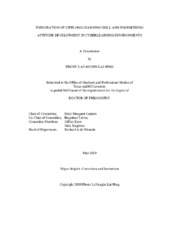| dc.contributor.advisor | Capraro, Mary M | |
| dc.contributor.advisor | Yalvac, Bugrahan | |
| dc.creator | Lai Hing, Ebony LaVaughn | |
| dc.date.accessioned | 2021-01-04T16:04:23Z | |
| dc.date.available | 2022-05-01T07:12:54Z | |
| dc.date.created | 2020-05 | |
| dc.date.issued | 2020-04-28 | |
| dc.date.submitted | May 2020 | |
| dc.identifier.uri | https://hdl.handle.net/1969.1/191728 | |
| dc.description.abstract | In the first study, I calculated reliability coefficients for the original LLL scale with good internal consistency. The exploratory factor analysis (EFA) yielded two factors (i.e., Learner characteristics and Enjoyment of reading and writing). The confirmatory factor analysis (CFA) measure model fit using five fit indices, initially had poor model fit except for one. After deleting items with low factor loading and low item-factor correlations the model fit was improved, yielding “good fit” for all indices.
In the second study, I calculated original EAS reliability coefficients with good internal consistency. EFA was performed resulting in four factors (i.e., Engineering as a career, Engineer career characteristics, Engineer career personality characteristics, and Engineering is theoretical). CFA model fit using the same five model fit indices did not yield good fit indices. Modifications to the EAS by deleting poor item-factor correlations resulted in improved reliability and construct validity for all of the model fit indices.
In the third study, I used the modified versions of the LLL and EAS and their sub-scales from the first two studies to explore if being educated through an EBP had any statistically significant effect on students’ LLL skills and EAs. I found that Factor 1 sub-scale of the EAS named “Engineering as a career” revealed statistically significant results. Students who were female, African American, first-generation college student in their immediate family showed the greater improvements in the “Engineering as career” sub-dimension of the EAS. In all other dimensions of the instruments, students’ mean score differences were improved after the modified versions were considered captured by the effect size differences.
I have identified proven methods, EBP, and improved assessment tools (i.e., modified LLL scale and modified EAS) that can positively impact and monitor vulnerable undergraduate populations and URMs in STEM undergraduate programs. | en |
| dc.format.mimetype | application/pdf | |
| dc.language.iso | en | |
| dc.subject | Evidence-Base Pedagogy | en |
| dc.subject | STEM Education | en |
| dc.subject | Engineering Education | en |
| dc.subject | Computer-Aided Design | en |
| dc.subject | Life Long Learning | en |
| dc.subject | Engineering Attitudes | en |
| dc.subject | HBCU,
Exploratory Factor Analysis | en |
| dc.subject | Confirmatory Factor Analysis | en |
| dc.subject | URM | en |
| dc.title | Exploration of Lifelong Learning Skill and Engineering Attitude Development in Cyberlearning Environments | en |
| dc.type | Thesis | en |
| thesis.degree.department | Teaching, Learning, and Culture | en |
| thesis.degree.discipline | Curriculum and Instruction | en |
| thesis.degree.grantor | Texas A&M University | en |
| thesis.degree.name | Doctor of Philosophy | en |
| thesis.degree.level | Doctoral | en |
| dc.contributor.committeeMember | Liew, Jeffrey | |
| dc.contributor.committeeMember | Singleton, Julie | |
| dc.type.material | text | en |
| dc.date.updated | 2021-01-04T16:04:23Z | |
| local.embargo.terms | 2022-05-01 | |
| local.etdauthor.orcid | 0000-0003-3554-5935 | |


